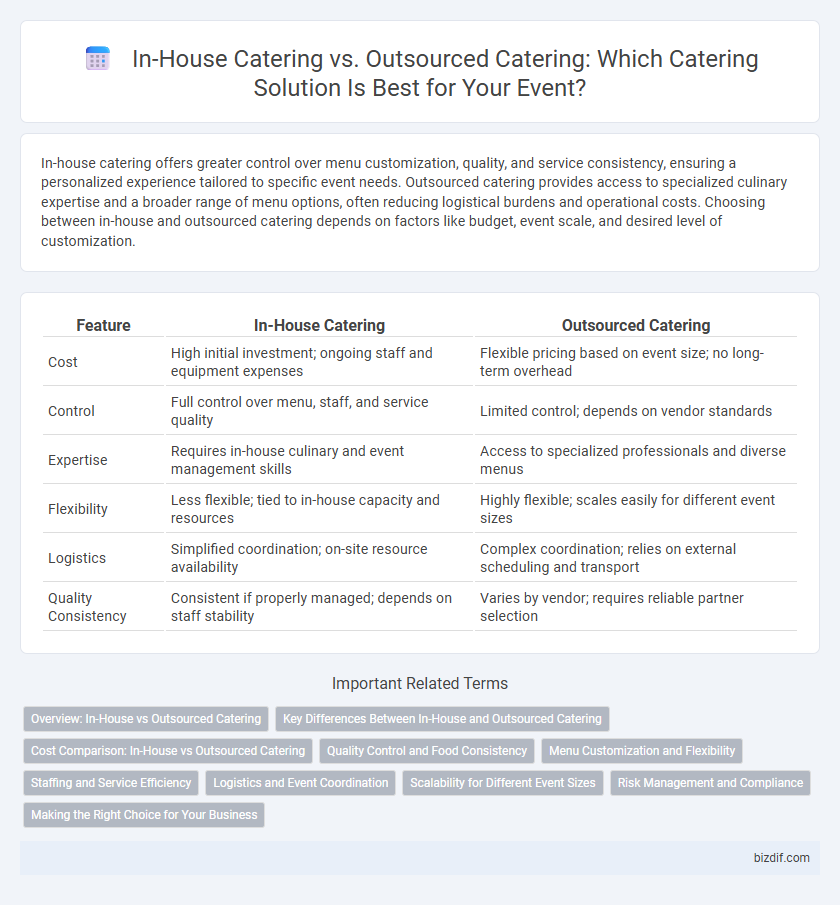In-house catering offers greater control over menu customization, quality, and service consistency, ensuring a personalized experience tailored to specific event needs. Outsourced catering provides access to specialized culinary expertise and a broader range of menu options, often reducing logistical burdens and operational costs. Choosing between in-house and outsourced catering depends on factors like budget, event scale, and desired level of customization.
Table of Comparison
| Feature | In-House Catering | Outsourced Catering |
|---|---|---|
| Cost | High initial investment; ongoing staff and equipment expenses | Flexible pricing based on event size; no long-term overhead |
| Control | Full control over menu, staff, and service quality | Limited control; depends on vendor standards |
| Expertise | Requires in-house culinary and event management skills | Access to specialized professionals and diverse menus |
| Flexibility | Less flexible; tied to in-house capacity and resources | Highly flexible; scales easily for different event sizes |
| Logistics | Simplified coordination; on-site resource availability | Complex coordination; relies on external scheduling and transport |
| Quality Consistency | Consistent if properly managed; depends on staff stability | Varies by vendor; requires reliable partner selection |
Overview: In-House vs Outsourced Catering
In-house catering involves managing all food preparation, staffing, and service internally, offering greater control over menu customization and quality standards. Outsourced catering contracts external companies to handle food and event services, providing access to specialized expertise and potentially lower operational costs. Decision-making between in-house and outsourced catering hinges on factors like budget constraints, event scale, and desired service flexibility.
Key Differences Between In-House and Outsourced Catering
In-house catering offers greater control over menu customization, staff management, and quality assurance, ensuring a consistent brand experience. Outsourced catering provides cost-efficiency by reducing overhead and leveraging specialized expertise but may limit flexibility in service adjustments. Evaluating factors like budget, event complexity, and desired control helps determine whether in-house or outsourced catering aligns better with organizational needs.
Cost Comparison: In-House vs Outsourced Catering
In-house catering typically involves higher upfront costs due to kitchen equipment, staff salaries, and ingredient procurement but offers greater control over menu customization and quality. Outsourced catering often reduces operational expenses by leveraging established vendors with bulk purchasing power and experienced personnel, leading to potentially lower per-head costs. Evaluating hidden fees, such as delivery charges and service fees in outsourced options, is crucial to assess the overall cost-effectiveness compared to in-house catering solutions.
Quality Control and Food Consistency
In-house catering offers direct oversight of quality control and ensures food consistency through hands-on management and immediate adjustments during preparation and service. Outsourced catering relies on contractual agreements and supplier standards, which may introduce variability in food quality and consistency due to less direct supervision. Maintaining high standards in outsourced catering requires rigorous vendor selection and continuous communication to align expectations and delivery.
Menu Customization and Flexibility
In-house catering offers extensive menu customization and flexibility, allowing direct collaboration with chefs to tailor dishes precisely to event themes and dietary requirements. Outsourced catering may provide a diverse menu but often adheres to set packages, limiting adjustments and personal preferences. Prioritizing in-house catering enhances control over ingredients, presentation, and last-minute changes, ensuring a unique and personalized dining experience.
Staffing and Service Efficiency
In-house catering offers direct control over staffing, enabling customized training and immediate adjustments to service standards, which often results in higher service efficiency tailored to specific event requirements. Outsourced catering relies on external teams that bring specialized expertise and scalability but may face challenges in consistency and alignment with the host organization's culture and expectations. Staffing flexibility in outsourced catering can reduce labor costs, yet potentially compromise personalized service levels compared to the dedicated focus found in in-house teams.
Logistics and Event Coordination
In-house catering offers direct control over logistics and event coordination, allowing seamless communication between chefs, servers, and event planners. Outsourced catering requires detailed coordination with external vendors to ensure timely delivery, setup, and compliance with venue regulations. Efficient logistics management in either approach is crucial for synchronized food service and overall event success.
Scalability for Different Event Sizes
In-house catering offers greater control and customization but may struggle with scalability for larger events due to limited staff and resources. Outsourced catering companies specialize in handling a wide range of event sizes, providing flexible menus and staffing solutions that can easily adapt to both small gatherings and large-scale functions. Choosing between in-house and outsourced catering depends on the event's size requirements and the ability to efficiently scale service without compromising quality.
Risk Management and Compliance
In-house catering allows for direct control over food safety protocols and staff training, minimizing risks related to contamination and regulatory non-compliance. Outsourced catering partners often bring specialized expertise in compliance with health regulations and industry standards, reducing liability through certified processes and liability insurance coverage. Effective risk management requires evaluating vendor credentials, monitoring adherence to food safety laws such as FDA and local health codes, and ensuring contingency plans for potential service disruptions.
Making the Right Choice for Your Business
Choosing between in-house catering and outsourced catering impacts cost efficiency, quality control, and scalability for your business. In-house catering offers direct oversight and customization tailored to company culture, while outsourced catering provides access to diverse menus and professional expertise without the need for internal resource allocation. Evaluating factors like budget, event frequency, and desired service flexibility ensures the optimal catering solution aligns with your business goals.
In-House Catering vs Outsourced Catering Infographic

 bizdif.com
bizdif.com